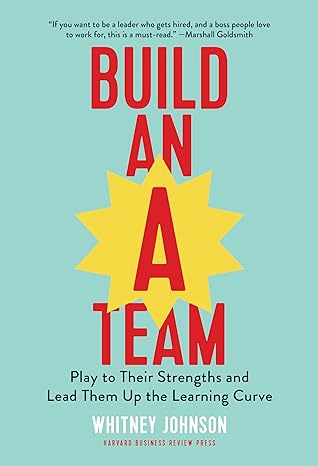
Build an A-Team: Play to Their Strengths and Lead Them Up the Learning Curve - By Whitney Johnson
Date read: 2018-06-23How strongly I recommend it: 8/10
(See my list of 150+ books, for more.)
Go to the Amazon page for details and reviews.
Discusses the S curve approach and how it's important for leaders to have a good mix of people on their team, related to their strengths and experience. Good for any leader trying to improve their team.
Contents:
My Notes
This is what people want on the job: to boldly go where they haven’t gone before. To venture into uncharted territory. To take themselves and their company where they’ve never been.
S curve math tells us that the early days of a role, at the low end of the S, can feel like a slog.
As we put in days, weeks, and months of practice, we will speed up and move up the S curve, roaring into competence and the confidence that accompanies it.
As we approach mastery, tasks become easier and easier. This is satisfying for a while, but because we are no longer enjoying the feel-good effects of learning, we are likely to get bored.
Your team should include employees who are at different phases of development. With roughly 15 percent at the low end, around 70 percent of the team in the sweet spot middle, and 15 percent at the high end of the curve.
Corporation executives may tell you that an organization cannot have too many good managers, but they are wrong. What it cannot do is keep them good without constantly giving them tasks that match up to their abilities.” Assign and reassign “to make sure that staff of high quality stays with the firm—and stays of high quality.”
The S curve represents three distinct phases of disruption:
In hiring for, or moving an employee to, a new role, skew toward market risk whenever possible. What needs aren’t being met on your team or in your business? Does it make sense to redistribute responsibilities among current team members? Create a new role? Would more high-quality candidates be available if you looked beyond the margins of a currently available job?
Why would you want a person to move on when they are at their best? Because “best” is temporary. After three to four years, most employees won’t continue to perform at their highest level without a change in the scope of their activities. Even the sharpest knife grows dull through repetitious use.
It’s not organizational disruption but personal disruption that drives innovation. Managers who can pair skill sets with problems to be solved are invaluable in initiating this disruption.
Create a milestone chart so you know if people are on track one month in, three months in, etc. If needed, course correct.
Hiring for potential rather than proficiency is the foundation for building an A-team.
The key to building a high-functioning team begins with a deliberate recruitment process: hire at the low end of the S curve.
New hires need a vision. Understanding why their job is necessary and important will power them through difficult days, when the cost of the struggle toward competence seems steep.
Managing up means thinking like a manager even when you aren’t. It’s about proving, through consistent, proficient work, that you can manage yourself and are therefore capable of increased responsibility.
When natural constraints have dissolved, you may consciously impose constraints of time, money, expertise, and buy-in. These forces can help bring to the fore the resourcefulness that stimulates innovation.
Questions you should ask:
If the people who work for you don’t get real responsibility—the kind of assignments that could lead to a large-scale failure but also to engagement, innovation, and higher profitability—they will never reach the peak of their ability.
To keep your team at its most effective, aim for 70 percent of your people to be in the sweet spot of their learning curve at any given time.
While they’re waiting to jump to their next curve, deploy them on crucial, but often neglected, tasks like setting the pace, passing along the tribal memory, and facilitating collaborations between less-experienced employees.
Success is everyone knowing the plan. That means knowing the status and forecast against the plan, the areas that need special attention to get back on plan, and being willing to work together to move from red to yellow to green. There are no failures. Knowing the status, the problems, and the challenges are the gems. With this attitude and transparency, we can work together to deliver toward the plan, the strategy, and the vision.
You will lose your high potentials. You can’t continue to “like them right where they are,” because they won’t stay. If you don’t help broker in-house moves to keep them stretching, they’ll broker their own move to a new employer.